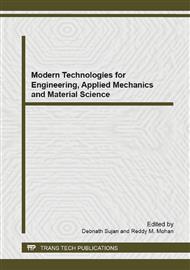[1]
Y. R. Loh, D. Sujan, M. E. Rahman, C. A. Das Sugarcane bagasse - The future composite material: Aliterature review, Resources Conservation and Recycling; vol. 75, 2013, p.14– 22.
DOI: 10.1016/j.resconrec.2013.03.002
Google Scholar
[2]
M. E. Rahman, A. Muntohar, Vikram P, Brabha H, & D. Sujan, Self Compacting Concrete from Waste Materials & Blended Fine Aggregate, Materials and Design; vol. 55, 2014, p.410–415.
DOI: 10.1016/j.matdes.2013.10.007
Google Scholar
[3]
L. Lancaster, M. H. Lung, and D. Sujan Utilization of Agro-Industrial Waste in Metal Matrix Composites: Towards Sustainability, World Academy of Science, Engineering and Technology, vol. 73, 2013, pp.1136-1144.
Google Scholar
[4]
S. Shinoja, R. Visvanathanb, S. Panigrahic, M. Kochubabua, Oil palm fiber (OPF) and its composites: A review, Ind. Crop. Prod. vol. 33, 2011; p.7–2.
Google Scholar
[5]
F.O. Okafor. Palm kernel shell as a lightweight aggregate for concrete,. CemConcr Res. vol. 18(6), 1988; p.901–10.
DOI: 10.1016/0008-8846(88)90026-9
Google Scholar
[6]
Teo DCL, Mannan MA, Kurian VJ, Zakaria I. Flexural behaviour of reinforced lightweight OPS concrete beams. In: 9th International conference on concrete, engineering and technology, Malaysia; 2006; p.244–52.
DOI: 10.3151/jact.4.459
Google Scholar
[7]
Jia Guo, 1 and Aik Chong Lua. Microporous Activated Carbons Prepared from Palm Shell by Thermal Activation and Their Application to Sulfur Dioxide Adsorption. Journal of Colloid and Interface Science, vol. 251, 2002; p.242–247.
DOI: 10.1006/jcis.2002.8412
Google Scholar
[8]
PooyaLahijania, ZainalAlimuddinZainala, Abdul RahmanMohamedb. Catalytic effect of iron species on CO2 gasification reactivity of oil palm shell char. ThermochimicaActa, vol. 546, 2012; p.24– 31.
DOI: 10.1016/j.tca.2012.07.023
Google Scholar
[9]
Suradi, S.S., Younus, R.M. and Beg, M.D.H. Oil palm bio-fibre-reinforced polypropylene composites: effects of alkali fibre treatment and coupling agent. " Journal of composites materials., vol. 45 (18), 2011; pp.1853-1861.
DOI: 10.1177/0021998310387686
Google Scholar
[10]
Majeed, K., M. Jawaid, A. Hassan, A. Abu Bakar, H. P. S. Abdul Khalil, A. A. Salema, and I. Inuwa. Potential Materials for Food Packaging from Nanoclay/Natural Fibres Filled Hybrid Composites., Materials & Design, vol. 46 (0), 2013; 391-410.
DOI: 10.1016/j.matdes.2012.10.044
Google Scholar
[11]
Faruk, Omar, Andrzej K. Bledzki, Hans-Peter Fink, and MohiniSain. Biocomposites Reinforced with Natural Fibres: 2000–2010., Progress in Polymer Science, vol. 37(11), 2012; pp.1552-1596.
DOI: 10.1016/j.progpolymsci.2012.04.003
Google Scholar


